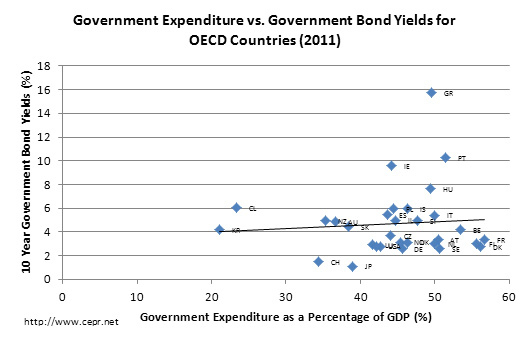
Article Artículo
The Debt is Not a Measure of Generational BurdensDean Baker / June 12, 2012
Article Artículo
Government Expenditure and Interest RatesMany of the leading voices in economic policy debates are telling us that excess government spending, like that characteristic of Western European welfare states over the past sixty years, leads ultimately to rising interest rates. This happens, it is argued, because excessive government spending is likely to crowd out private investment and consumption. This will slow growth and lead to higher inflation.
However, a cursory glance at recent data on government spending and the interest rates of government bonds reveals a different story. For 2011, we plotted government expenditure as a percentage of GDP versus the yields on ten-year government bonds for the OECD countries, and found a slight positive relationship between spending and interest rates, as is shown in the following figure.
 While a small positive relationship appears to exist, as can be seen by the upward slope of the line of best fit in the chart above, regression analysis of bond yields and government expenditure showed that this relationship was not statistically significant. Any miniscule positive relationship can be attributed to a few countries with high government expenditure as share of GDP and high bond yields. These are the European economies of Greece, Portugal, and Ireland. While it is possible that government spending played a role in precipitating the current crisis in Greece, this is not the case for the other distressed economies. For instance, Ireland and Spain both ran budget surpluses in the years just before the recession. Noteworthy, also, are the many countries, such as France, Denmark, Finland, and Belgium, with high government expenditure and very low bond yields.
While a small positive relationship appears to exist, as can be seen by the upward slope of the line of best fit in the chart above, regression analysis of bond yields and government expenditure showed that this relationship was not statistically significant. Any miniscule positive relationship can be attributed to a few countries with high government expenditure as share of GDP and high bond yields. These are the European economies of Greece, Portugal, and Ireland. While it is possible that government spending played a role in precipitating the current crisis in Greece, this is not the case for the other distressed economies. For instance, Ireland and Spain both ran budget surpluses in the years just before the recession. Noteworthy, also, are the many countries, such as France, Denmark, Finland, and Belgium, with high government expenditure and very low bond yields.
CEPR and / June 12, 2012
Article Artículo
The Stock Bubble Created the Budget Surplus: Not Bill Clinton's Tax and Spending PoliciesDean Baker / June 12, 2012
Article Artículo
Romney's Education Agenda: Beliefs Do Not Replace PoliciesDean Baker / June 12, 2012
Article Artículo
Getting Around the Mortgage Pool Problem With CondemnationDean Baker / June 11, 2012
Article Artículo
When It Comes to Europe, Robert Samuelson Is Upside DownDean Baker / June 11, 2012
Article Artículo
Why Would an Economist Expect Home Sales to Rise From Current Levels?Dean Baker / June 10, 2012
Article Artículo
Labor Market Policy Research Reports June 2 – June 8, 2012CEPR and / June 08, 2012
Article Artículo
Take Away the Patent Protection: The Answer to Uwe Reinhardt's QuestionDean Baker / June 08, 2012
Article Artículo
Correction for Fareed Zakaria: Tax Cuts Sort of Work and There Was No Simpson Bowles Commission PlanDean Baker / June 08, 2012
Article Artículo
IMF Chief Praises Latvian "Success Story" – A Scary Speech for the EurozoneMark Weisbrot / June 07, 2012
Article Artículo
If Clinton's Economic Record Is Viewed Positively, Then It Speaks to the Horrible State of Economic ReportingDean Baker / June 07, 2012